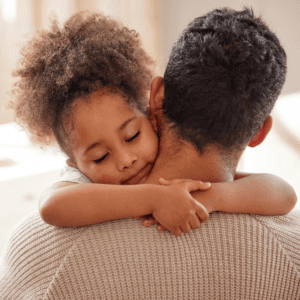The experience of losing a family member or pet can bring up challenging and complicated feelings and questions for the whole family.
In addition to their age, a child’s personality, relationships, and previous experiences can have a significant impact on their experience of death. Likewise, experiences of both grief and of healing will be strongly influenced by culture, religious or spiritual beliefs, and previous lived experiences. The following are some general best practices, but your family’s ways of grieving, healing, and supporting one another will be unique.

For most children and teenagers
When dealing with grief, most children and teenagers need:

To express their feelings, questions, and worries. Death can prompt new realizations and fears about life and loss, and children look to their trusted caregivers to help them understand this part of life and to get reassurance that they are safe. You can help them with this by validating their feelings and answering their questions nonjudgmentally. When you validate a child’s feelings, you are showing that you understand how they’re feeling, that you accept it as a legitimate way of feeling, and that you love them just the same. You may or may not share their same feeling; it’s not about having the same experience, but about accepting their experience. “I know that you’re really sad that Grandma died. I am too. What are you wondering about?” or “You seem to be really angry since we found out that Uncle Jerry died. That can happen when someone dies. Want to tell me about what you’re thinking about?”
Clear, honest language. Many cultures and families use euphemisms for dying like “passed on,” “lost,” “didn’t make it” or “went away.” For parents, this often comes from our wish to protect our children from pain. However, this kind of language can lead to more confusion or fear for children. Children might fear that sleep can cause death, for example, or wonder if friends who “go away” will die.

It is OK to tell a child or teen that someone died, and to use the word “death.” If they want to know more, explain it in language they can understand. For younger children, this might sound something like, “Pop-pop died because his body was very old and stopped working. Your body and my body are young, strong, and work really well.” For older children, you may choose to explain the basics of a diagnosis or illness like saying, “Rover had cancer. That means that he had cells growing where they weren’t supposed to be growing, and that stopped his body from working how it was supposed to.” Teenagers typically understand what death is and what can cause it, and will still benefit from being able to talk with you honestly about what happened. This might sound like, “Tina had alcoholism, and died because her liver failed. What questions do you have?”
To maintain routines as much as possible. When someone dies, it is normal and expected that your family’s daily routine might be interrupted. However, it can be helpful for children and teenagers to get back into a routine. Routines can be comforting to children because they know what to expect, and can feel a familiar sense of control over their activities and choices. When they’ve experienced a big change like a loss, this can make them feel safer. You’ll want to find the balance between honoring your family’s needs and feelings and maintaining a consistent rhythm. This might look something like going back to school and regular activities while carving time in the evenings and weekends to talk about how they’re feeling.

To honor and remember the loved one who died. Sometimes adults are uncomfortable talking to children about someone who has died because they fear it will make the child sadder. However, just as it can be healing for adults to honor loved ones, children also can experience healing when given the opportunity to remember their loved ones. This might look something like attending a funeral or memorial. If this isn’t possible or appropriate for your child, consider doing a family celebration of your loved one’s life in a way that makes sense for your children’s developmental age. It’s OK – and can be a good way of grieving – to share stories, look at photos, or draw pictures of your loved one.
Patience. Just as our adult experience of loss changes over time, children and teenagers will go through different phases of feelings, understandings, and acceptance after someone dies. You can help your child heal from and understand death by continuing to practice these strategies in the weeks, months, and years following your family’s loss.

By Age
A child’s developmental age influences their response to death. Understanding this can be helpful in understanding how best to support them, what behaviors are typical, and what behaviors may be cause for professional mental health intervention.
Additional Resources
This project on Improving Mental, Behavioral and Academic Supports to Students and Families, Part 2 is supported by the Centers for Disease Control and Prevention of the U.S. Department of Health and Human Services (HHS) as part of a financial assistance award totaling $434,555 with 100 percent funded by CDC/HHS. The contents are those of the author(s) and do not necessarily represent the official views of, nor an endorsement, by CDC/HHS, or the U.S. Government.

